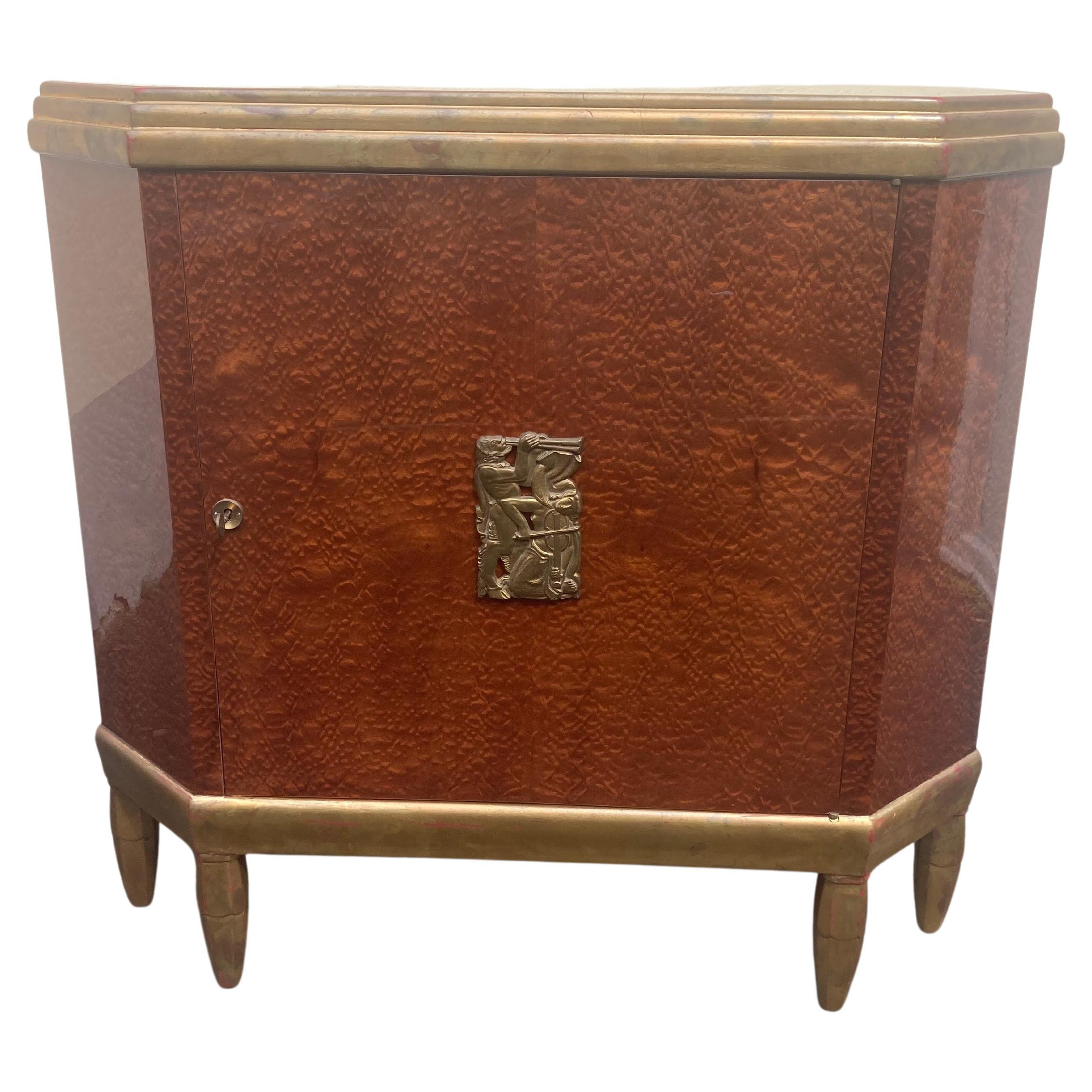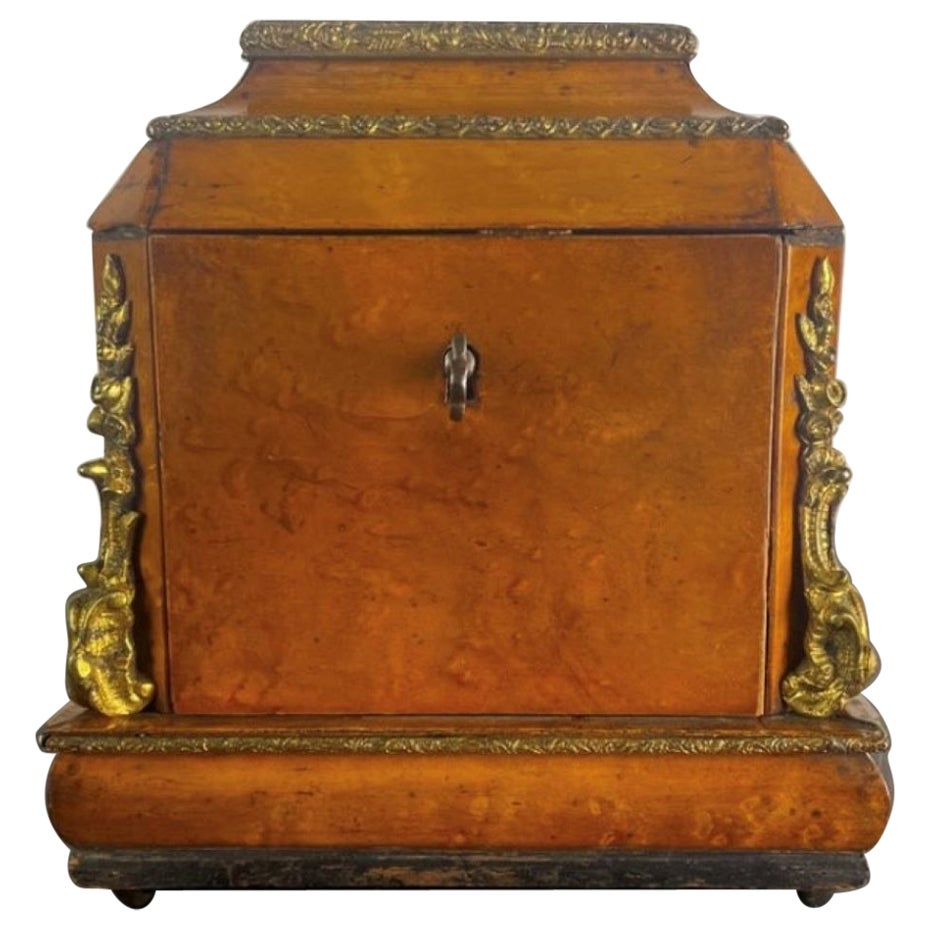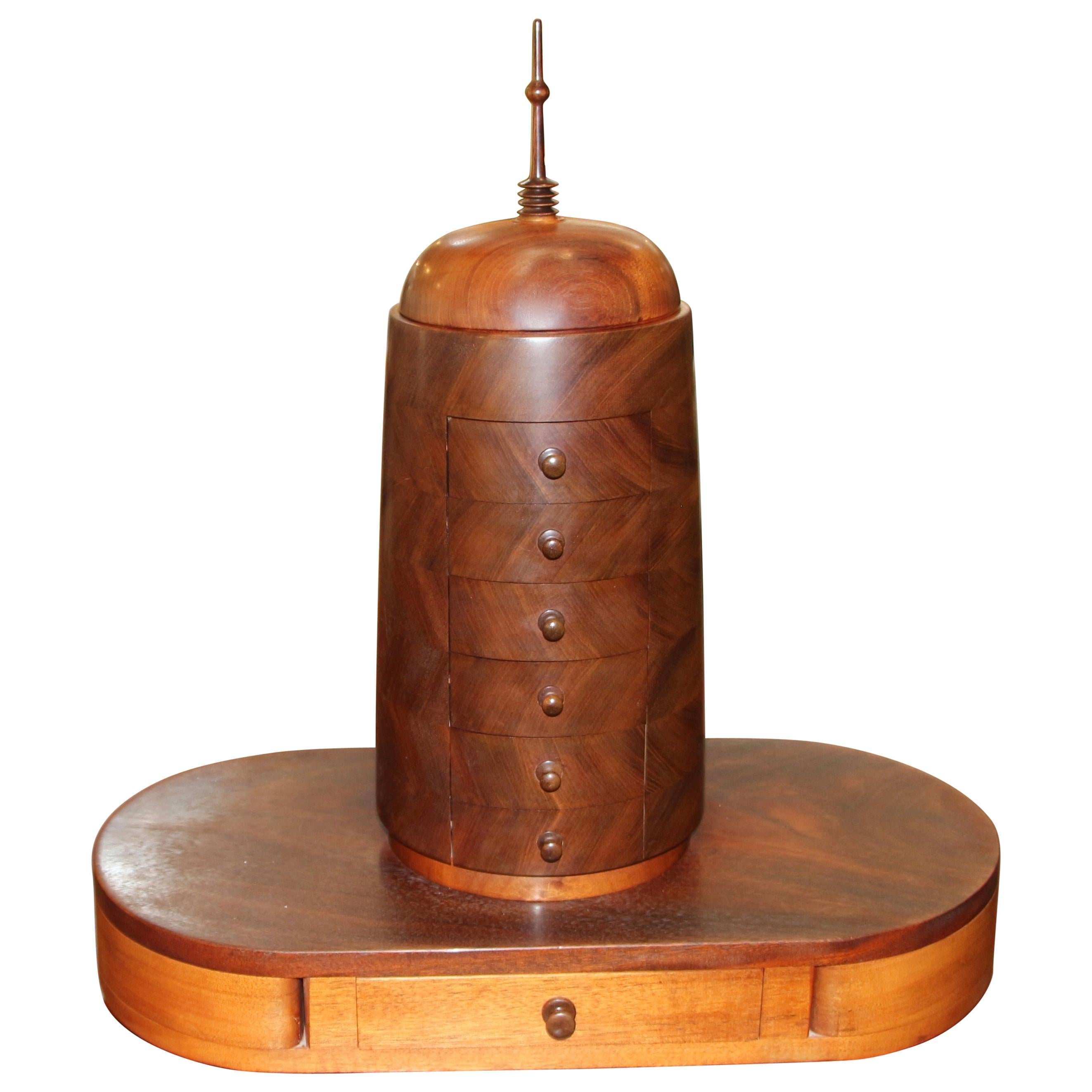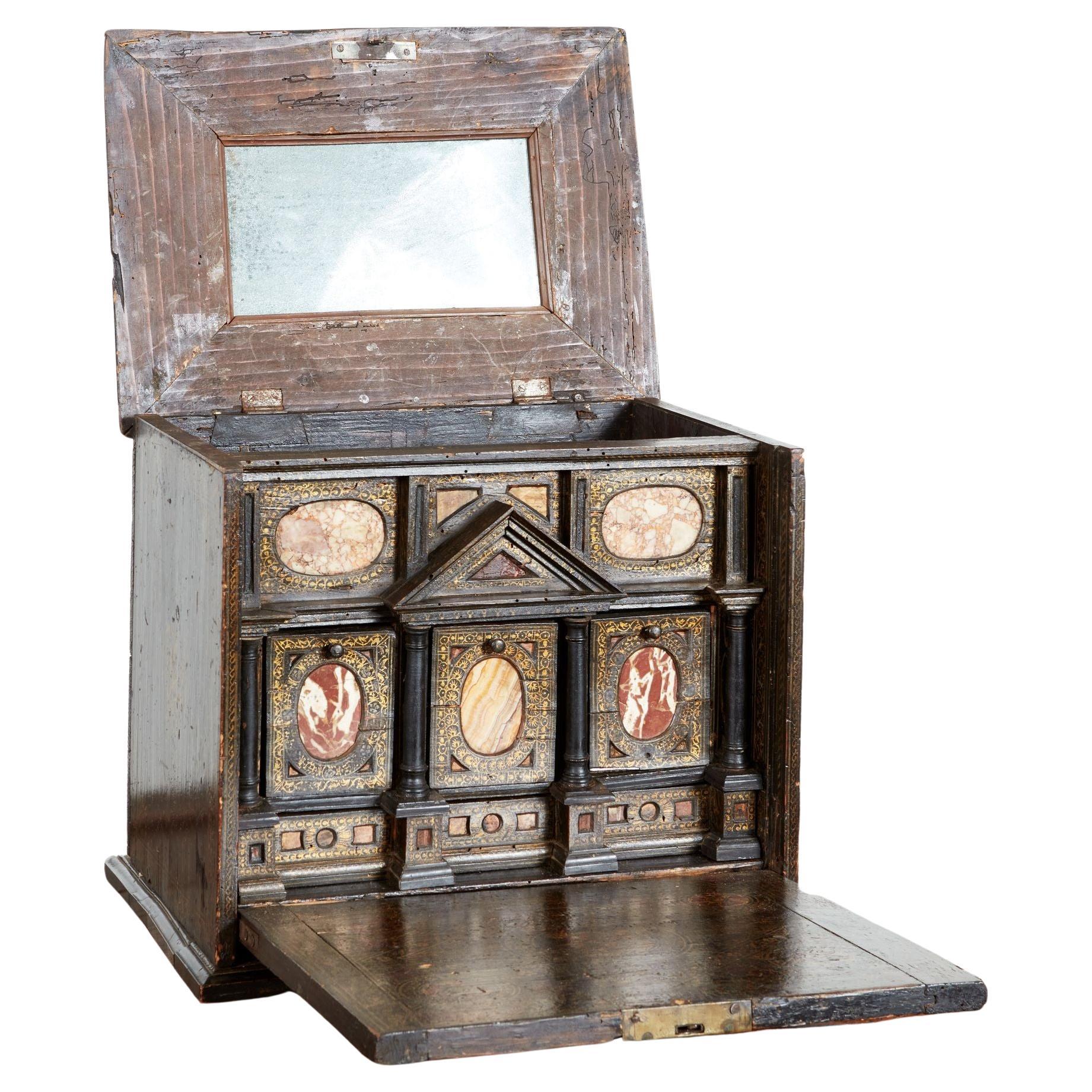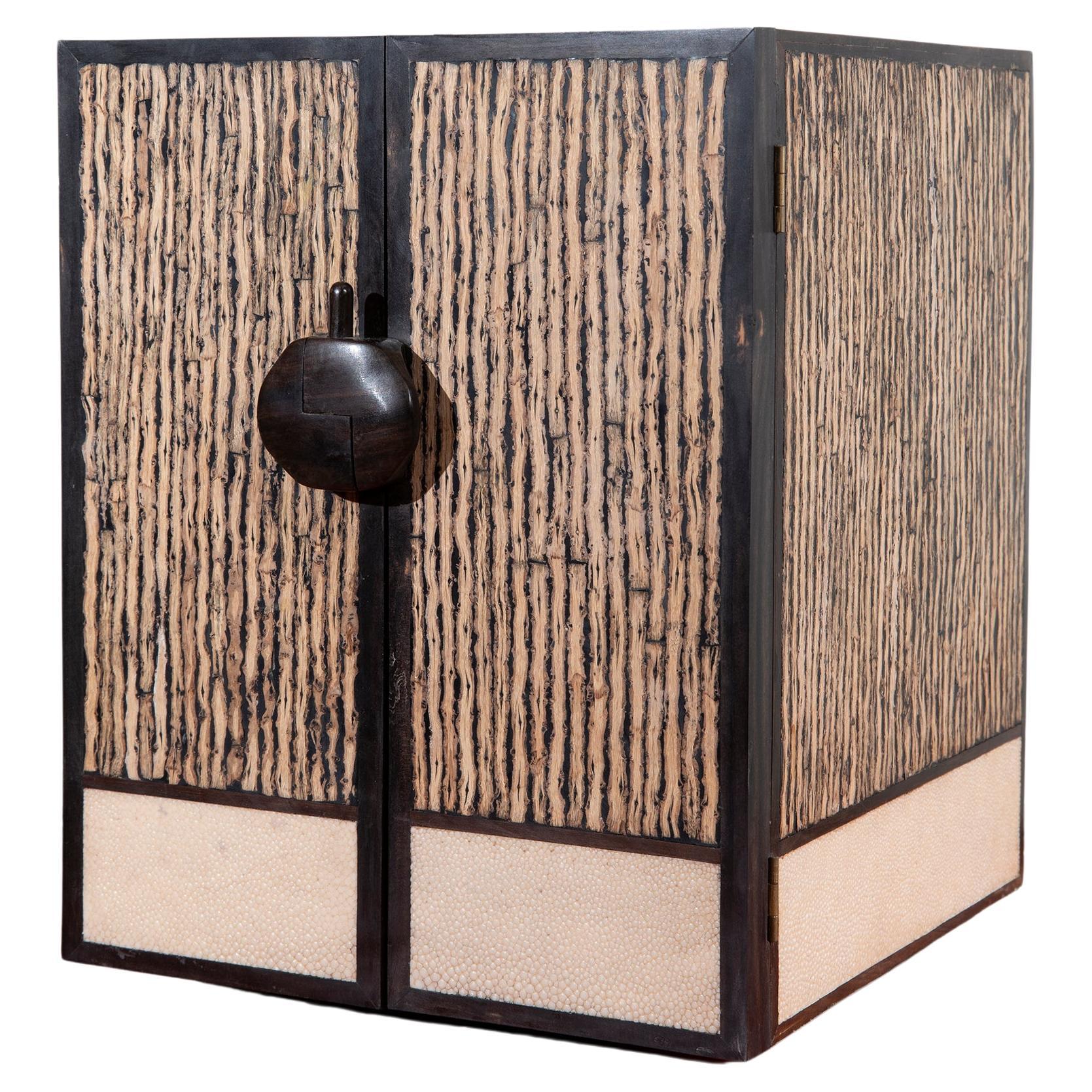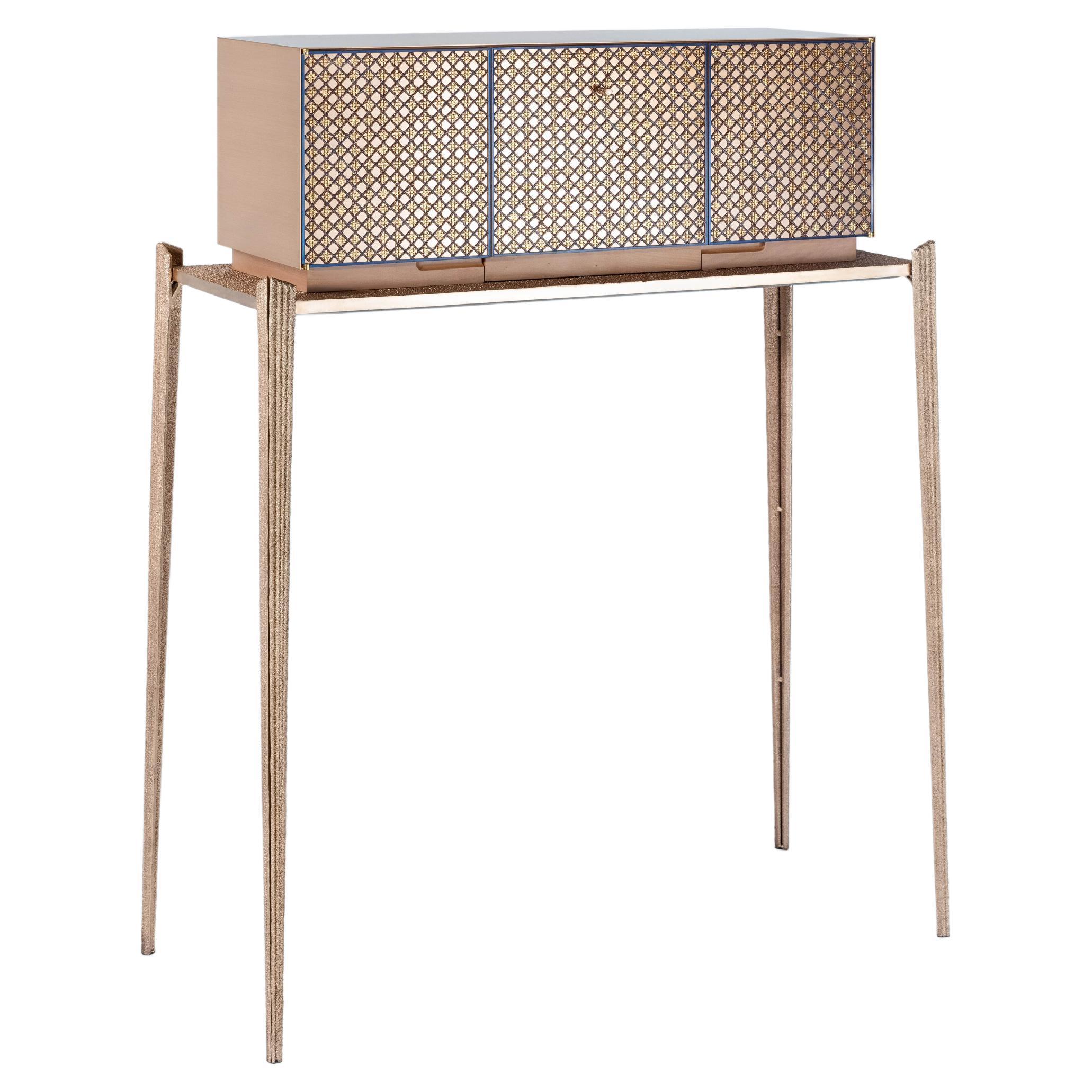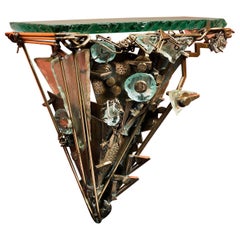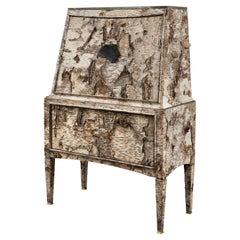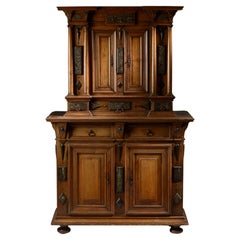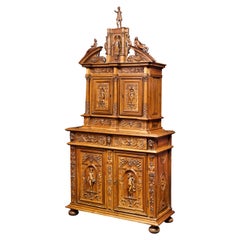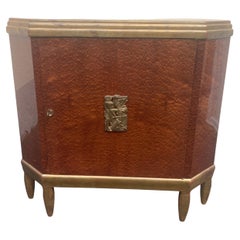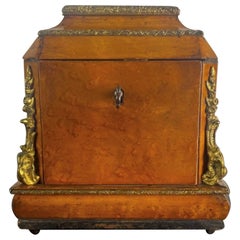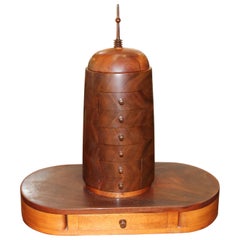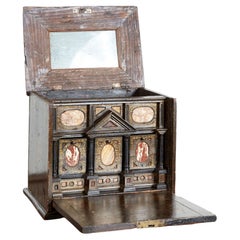Items Similar to Cabinet de Bois, Métal et Pierre Dures, Création Contemporaine de Daniel Arnoul
Want more images or videos?
Request additional images or videos from the seller
1 of 5
Cabinet de Bois, Métal et Pierre Dures, Création Contemporaine de Daniel Arnoul
$29,953.59
£22,294.37
€25,000
CA$41,028.93
A$45,633.13
CHF 23,828.20
MX$555,306.60
NOK 304,322.48
SEK 285,400.80
DKK 190,316.27
Shipping
Retrieving quote...The 1stDibs Promise:
Authenticity Guarantee,
Money-Back Guarantee,
24-Hour Cancellation
About the Item
EXCEPTIONNEL CABINET DE BOIS, MÉTAL ET PIERRES DURES
CRÉATION CONTEMPORAINE DE L’ORFÈVRE DANIEL ARNOUL
ORIGINE : FRANCE
PERIODE : XXe SIÈCLE, 1995.
Pièce unique, signé et daté
Métal, pierres dures (agathe, cornaline, cristal de roche), bois de violette, loupe d’orme.
Sculpteur ou orfèvre ?
Profane ou sacré ?
D’aujourd’hui ou d’hier ?
Daniel Arnoul ne s’inscrit pas dans les courants traditionnels.
Etre sculpteur n’était pas vraiment sa formation. Après avoir commencé des études à l’école du Louvre en orfèvrerie, et mis ses talents au service de la maison Puiforcat, il prit conscience de sa double nature d’artisan et d’artiste-créateur et compléta sa formation.
Chez le sculpteur Agam, il trouva la dimension, l’ampleur recherché pour laisser libre cours à une imagination fertile et créatrice.
Depuis son installation à Nice en 1980 son travail fut jalonné d’œuvres oniriques et symboliques, médiévales par leur inspiration et les matières employées : métaux rares, pierres dures semi-précieuses, monnaies antiques, perles.
Ainsi naquirent portraits, boites reliquaires, animaux fantastiques, mains royales, bijoux et cabinets tels que celui présenté ici, objet produit depuis la Renaissance, mais traité dans une ornementation proche de celle des objets sacrés médiévaux.
Pour cela Daniel Arnoul parcourt le monde, à la recherche de matériaux rares (argent, vermeil, cuivre, ivoire) de pierres (agathe, corail, cristal, lapis lazuli, grenat, améthystes, jaspes et cornaline), perles, ébène et bois exotique.
Le cabinet que nous présentons ici répond à ces critères.
Surélevé au-dessus d’une succession de quatre plate-forme de taille décroissante, le cabinet ouvrant de deux côtés ressemble à un tabernacle.
Le tout est orné de plaques d’argent et de vermeil travaillées au repoussé maintenues par d’autres en acier et laissant apparaître des pierres dures polies et serties.
Quatre tiges sommées par une boule de cristal de roche soutiennent ce cabinet précieux et traversant les quatre plaques reposent au sol, constituant l’armature maîtresse de cet ensemble.
Le cabinet proprement dit ouvrant sur ses deux côtés, par une double ouverture
La première, une sorte de hublot découvre l’intérieur au travers d’une fenêtre circulaire.
La deuxième s’abattant et entraînant le hublot, laisse apparaître trois tiroirs simulant un décor architectural. Les deux inférieurs coulissent dans un ensemble amovible, actionné lorsque l’on tire le tiroir supérieur, le tout traité en marqueterie de bois exotiques de couleurs variées.
Chacune des plaques présente au centre une ouverture circulaire, et même les deux tiroirs reposant sur la seconde et la troisième vitre également circulaire. Leur décor mêle le bois clair et les plaques de vermeil repoussé parcourues d’un décor de petit galets.
Une impression de secret et de sacré se dégage de cette œuvre ajoutant à la beauté du travail et des matériaux, une dimension supplémentaire indéfinissable.
- Creator:Daniel Arnoul 1 (Artist)
- Dimensions:Height: 29.53 in (75 cm)Width: 26.78 in (68 cm)Depth: 25.01 in (63.5 cm)
- Materials and Techniques:
- Period:1990-1999
- Date of Manufacture:1995
- Condition:
- Seller Location:Saint-Ouen, FR
- Reference Number:1stDibs: LU3115327609772
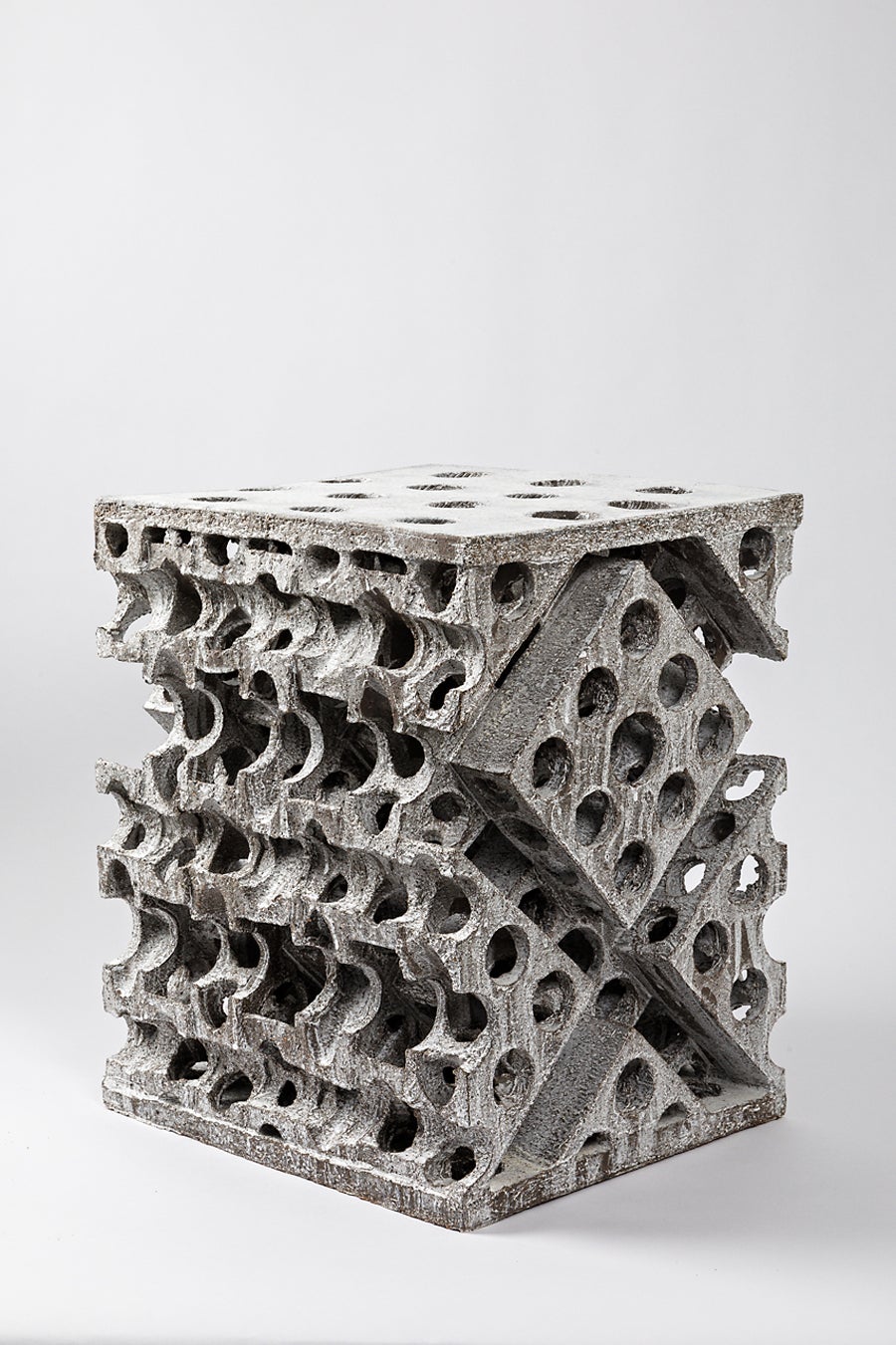
About the Seller
5.0
Vetted Professional Seller
Every seller passes strict standards for authenticity and reliability
Established in 2016
1stDibs seller since 2017
189 sales on 1stDibs
Typical response time: 3 hours
- ShippingRetrieving quote...Shipping from: Saint-Ouen, France
- Return Policy
Authenticity Guarantee
In the unlikely event there’s an issue with an item’s authenticity, contact us within 1 year for a full refund. DetailsMoney-Back Guarantee
If your item is not as described, is damaged in transit, or does not arrive, contact us within 7 days for a full refund. Details24-Hour Cancellation
You have a 24-hour grace period in which to reconsider your purchase, with no questions asked.Vetted Professional Sellers
Our world-class sellers must adhere to strict standards for service and quality, maintaining the integrity of our listings.Price-Match Guarantee
If you find that a seller listed the same item for a lower price elsewhere, we’ll match it.Trusted Global Delivery
Our best-in-class carrier network provides specialized shipping options worldwide, including custom delivery.More From This Seller
View AllConsole Jewellery III by Michel Kiriliuk
By Michel Kiriliuk
Located in Saint-Ouen, FR
Unique piece. Dated 1990.
Engraved brass, metal and glass slab.
This unique and original piece of art was sculpted by Michel Kiriliuk. Born French and self-educated this sculptor...
Category
20th Century European Cupboards
Materials
Metal, Brass
Sophie Gallardo and Georges Casssan, "Australian Desk", Unic and Stamped Piece
By Sophie GALLARDO, George-Guillaume CASSAN
Located in Saint-Ouen, FR
Full height : 133 cm including 2 cm marble
Length : 90 cm
Depth : 44 cm
Table top : 82.5 x 70 cm
Inner dimensions « lower part »
Length : 76 cm
Depth : 44 cm
Made from an Italian desk from the late 1940s.
Birch bark marquetry and mineral inlays : stone, labradorite (inside outside), amethyst, crystals. The inside is enriched with straw marquetry and patinated silver foils.
The two doors present marquetry on both sides with an inner mirror to provide light and reflect the top marquetry. Rock crystal handles, Rain forest green marble from Rajahstan.
Sophie Gallardo has studied interior design before learning wood painting restoration...
Category
21st Century and Contemporary French Other Secretaires
Materials
Birch
Small Cabinet by l'Ecole de Fontainebleau Incrusted with Marble Tablets
Located in Saint-Ouen, FR
Small cabinet by L’ecole De Fontainebleau Incrusted with marble tablets
Origin : VAL-DE-LOIRE, France
Period : 16th century
Measures: Height : 170...
Category
Antique 16th Century Renaissance Cabinets
Materials
Walnut
Renaissance Cupboard from Loire Valley, 'France'
Located in Saint-Ouen, FR
This cabinet is composed of two bodies, the upper one being recessed. The extraordinary proportions are enriched by a mythological and floral carved decor.
The Lower body stands o...
Category
Antique 16th Century French Renaissance Cabinets
Materials
Walnut
Important Renaissance Cabinet from Lyon 'France' with a Decor of Perspectives
Located in Saint-Ouen, FR
As soon as 1540 France's second Renaissance is in the making, intimately linked to the rediscovery of the Antique world. The development of the printing and engraving industry allows the spread of artworks and models in many cities and countries. The Italian influence can be perceived in every artistic field. While the French king entrust the most talented Italian artists with major projects such as Il Rosso or Primaticcio in Fontainebleau, French artists also travel to Italy to form themselves to this new style. In Italy they get acquainted with the work of Leo Battista Alberti the first to theorize perspective (De Pictura, 1435-36) and architecture (De re oedificatoria, 1541). Those two publications would have a revolutionary impact on arts.
Furniture is marked by the work of the most famous Italian architects of the time as well as French architects. Indeed Philibert de l'Orme competes with Alberti and by the end of his life publishes several treaties including one devoted to a theory of architecture (1567). Unfortunately he would not live to complete the second volume. In this treaty he expresses his interest for mathematical norms applied to architecture, copied from the Antique. His journeys in Italy allowed him to accumulate the most sophisticated references. Jean Bullant, another architect of great talent also theorizes his practice. He establishes rules characterizing Greco-Roman art staying faithful to Vitruvius.
Following this new inspiration the structure of furniture evolves. From then on appear columns, capitals, cornices, friezes and architraves. The ornamentation uses this inspiration as well with egg-and-dart, palm leaf and rose adorning the most beautiful pieces.
In Lyon, crossroad where meet merchants from everywhere those new experiments are welcomed. Lyon florishing printing industry allows the spreading of models and treaties essential to the artist's work. Thus the first publication of Vitruvius' De Architectura in France would be printed in Lyon in 1532.
Artists from Lyon rediscover and familiarize themselves with the Antique knowledge very early. They adopt those new ideas and use them in their own creations. Lyon cabinet-makers re interpret Antique architecture and Italian Renaissance palaces to give their pieces a pure and harmonious architectural structure. Grooved pilasters are particularly favored. They are topped by capitals of diverse orders always respecting the sequencing with simpler ones for the lower levels and the richest ones on the higher levels. As for the ornamentation, one of the great distinctiveness of Lyon workshops remains the architectural perspective illusions, drawing inspiration from Tuscany.
True masterpiece of the Second French Renaissance this important cabinet illustrates Lyon workshops' taste for fine Italian architecture inspired by Antiquity. An architectural perspective of great quality is treated in symmetry on each panel.
This two-bodied cabinet without recess stands on four rectangular feet. The base comprises a molding, a palm leaf frieze and is bordered by a braid.
The lower body is divided by three grooved pilasters with Tuscan capitals framing two door-leaves. The two panels are encircled by a moudled frame with palm leaves. They are finely carved with a decor of fantasized architecture depicting an Italian Renaissance palace erected symmetrically on each side of a grooved pilaster. On the ground floor a door opens through a stilted arch while the stories are opened with mullioned windows, dormers and occuli. Two large pegged-boss cladded pillars support the entablature enriched by a palm leaf frieze upon which stands an arch whose coffered intrados is centred by a rose. Behind this arch a pyramid appears, standing in front of a second facade with a window topped by a broken curvilinear pediment under a cul-de-four with a shell.
The checker flooring gives depth to the low-reliefs creating vanishing points structuring the panels and guiding the eye of the observer.
A thin laurel braid highlights the belt of the cabinet where are located two drawers. Their facades are adorned by palm leaves in hoops.
The upper body is encircled with palm leaves. The same ternary division as in the lower body appears. However, the pilasters are topped by Ionic capitals with volutes and egg-and-dart. The door-leaves are framed with flowers. On the panels the artist has designed another architectural decor. On the foreground open two arches on top of grooved pilasters with rectangular capitals adorned with palm leaves. The arches are enriched with braids and the coffered intrados bears a decor of roses. The spandrels also bear a flower decor. In the background another arcature hosts a fluted grooved column topped with double basket acanthus capital, characteristic of Corinthian order. The triangular pediment is interrupted by a choux bourguignon.
A large cornice crowns the cabinet. It stands on pilasters and forms an entablature comprising a palm leaf frieze and an egg-and-dart, triglyph and palm leaf cornice.
The cabinet's sides have also been carefully considered. The lower body's panels are enriched with an arch rising above a broken pediment portico hosting a twisted column. Flowers garnish the spandrels. An architectural facade completes the decor. The upper body's panels present two arches supported by a facade opened with dormers and mullioned windows as well as cartouches (one bears the inscription 1580 dating the cabinet) suggesting the interior of an Italian Renaissance palace, confirmed by the chandeliers. The flooring leads our gaze to a second arch with a broken curvilinear pediment where stands a flower vase. This arch opens onto a perspective of another facade along a road.
Inside the cabinet, on the lower body door-leaves appear two designs. On the right door is depicted a Crucifixion. Saint Mary and Saint John flank the Christ on the cross. In the bottom part is inscribed « Dure uiator abis nihil haec spectacula curas / Pendenti cum sis unica cura Deo. / Tota suo moriente dolet natura Magistro. / Nil qui solus eras caussa dolenda doles. ». The signature [Christoff Swartz Monachiensis pinx[it] / Ioa[nnes] Sadeler sculp[it]] tells us it was made by Johan Sadeler I (1550-1600) after Christoph Schwartz (1548-1592). This engraving belongs to an ensemble depicting the Passion of Christ Johan Sadeler executed in 1589 after an altar piece painted by Christoph Schwartz for the private chapel of Renée of Loraine, wife of Duke William V of Bavaria. This altar piece made of nine copper panels has been destroyed during the 19th century. The Crucifixion panel once in the centre of the altar piece is the only one that survived and is today kept in Munich's Alte Pinakothek.
On the left door appears Saint Francis receiving the stigmata. The inscription says : « Signastidomine Servum Tuum. Franciscum. Signis Redemptionis Nostrae ».
This Renaissance cabinet with an architectural decor appearing as much in the structure faithful to Antique rules...
Category
Antique 16th Century European Renaissance Cabinets
Materials
Walnut
Sophie Gallardo and Georges Cassan, "Louis XIII Period Chest"
By Sophie GALLARDO, George-Guillaume CASSAN
Located in Saint-Ouen, FR
Measures: Height : 60 cm
Length: 116 cm
Width : 67 cm
Birch bark marquetry and mineral inlays
Interior : turn inside out calf
Original silver metal hinge
Sophie Gallardo has studied interior design before learning wood painting restoration...
Category
21st Century and Contemporary French Other Blanket Chests
Materials
Birch
You May Also Like
Art Déco cabinet by Pierre Paul Montagnac. France 1920s.
By Pierre-Paul Montagnac
Located in Köln, NW
French Art Déco cabinet by Pierre Paul Montagnac.(1883 to 1961) with bronze application.
Thuja root wood, gilded feet and border.
Interior oak wi...
Category
Vintage 1920s French Art Deco Cabinets
Materials
Bronze
Jewelry Boxes or Wooden Box with Key, Restauration Period 19th, France
Located in Beuzevillette, FR
Charming jewelry box or case.
The box has a compartment for rings and 3 compartments for earrings, necklaces, bracelets, stones.
Very interesting opening mechanism with pusher syst...
Category
Antique Mid-19th Century French Restauration Jewelry Boxes
Materials
Wood
Craftsman's Handmade Jewelry Cabinet
Located in Palm Springs, CA
A wonderful handmade craftsman's jewelry cabinet. Beautifully constructed out of mahogany and a secondary wood I can't identify. It has drawers lined...
Category
Vintage 1980s American Jewelry Boxes
Materials
Wood
$1,560 Sale Price
67% Off
Venetian Renaissance Jewelry Chest
Located in Greenwich, CT
Rare Venetian 16th century Italian traveling jewelry chest profusely decorated in Arabesque black and gilt decoration featuring rare specimen stone drawer fronts in a Palladian archi...
Category
Antique 16th Century Italian Jewelry Boxes
Materials
Wood
R&Y Augousti, shagreen jewelry box, 1990s
By R & Y Augousti
Located in Firenze, IT
Stunning shagreen and ebonized wood jewelry box, produced by R&Y Augousti in the 1990s. It is a very sophisticated jewelry box full of elegant details, the doors are closed by a Japa...
Category
1990s French Modern Jewelry Boxes
Materials
Shagreen, Wood
Jean-Luc Le Mounier, Contemporary Jewel Box with Finely Embroidered Doors
By Jean-Luc Le Mounier
Located in New York, NY
By employing ever-more complex techniques, wedding rare species of wood and precious metals in novel arrangements, and endowing each piece with incredible components, Jean-Luc Le Mou...
Category
2010s French Commodes and Chests of Drawers
Materials
Bronze
